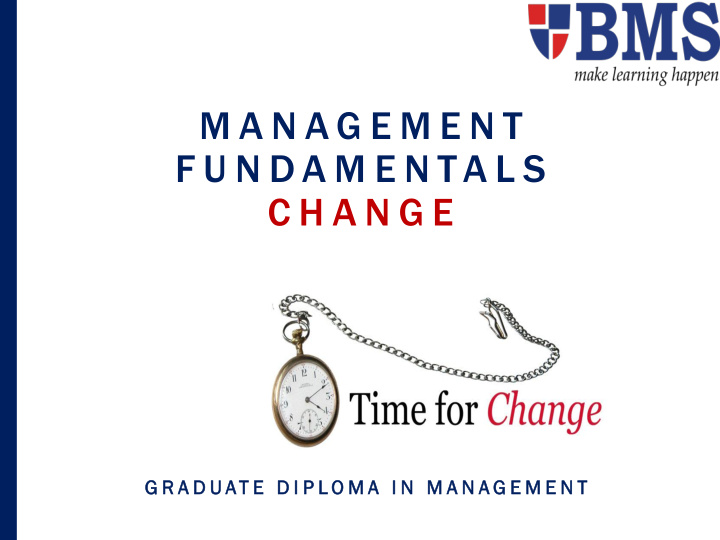



M A N A G E M E N T F U N D A M E N TA L S C H A N G E G R A D U AT E D I P L O M A I N M A N A G E M E N T
Page 344 De Defin inition ition – Organization rganization Change hange The adaptation of a new idea and behaviour by an organization R. L. Daft E.g. New idea Introduce a new variant to the existing product range New behaviour Start exporting your products
Discussion WHY COMPANIES SHOULD CHANGE ? IF COMPANIES DO NOT CHANGE WHAT WOULD HAPPEN TO THEM?
Change is needed for the survival
KODAK Kodak dominated in the photographic film industry in the 20 th century. The company failed to get adopted with and take the initiation in the digita tal photogra ograph phy y revolu oluti tion on Infact, the management were hesitating to change and to perceive the digital photography as the next disruptive innovation by that time The company announced bankruptcy in 2012 12
Since 1930, Unilever has operated with two head offices - a British PLC headquartered in London and a Dutch NV based in Rotterdam in Netherlands. Unilever employs 7,300 people Paul Polman in the UK and 3,100 in the Ex-CEO Unilever Netherlands Unilever House - London Year ago, Unilever reorganized its business into three divisions: beauty and personal care, home care, foods and refreshment. The first two divisions to have their headquarters in London, while the third will continue to be based in Rotterdam
FORCES INFLUENCE CHANGE External Internal forces forces Customers, competitors, PESTEEL factors Need for Goals/objectives, and market change plans, company conditions problems Mangers should study these forces and implement the necessary changes without delaying
FACTORS DRIVING ORGANISATIONAL CHANGE • Internal ernal Organi anizati zation onal l Fact ctor ors – New organisational strategy (e.g. Cost so high, need to reduce) – Change in composition of workforce (e.g. Talented employees leave organization) – New equipment (e.g. Existing old machines need regular repairing) – Changing employee attitudes (e.g. Poor teamwork) • Ex Externa ernal l En Environme onmental ntal Fact ctor ors – Changing consumer needs and wants (e.g. customers are moving to competitors new product range) – New government laws (e.g. tax revision by the government) – Changing technology (e.g. Need to start selling online) – Economic changes (e.g. macro economical conditions are becoming more and more tough)
TYPES OF CHANGES Incremental Change Step-wise Change - Minor changes - Drastic changes - Easy to manage - Difficult to manage - Less risky - Risky - Less time consumed
Page 346 CHANGES TO BE WELL PLANNED People and Cultural changes Among other changes, there are 3 changes which are critical to an Technology organization and therefore changes need effective prior planning Product changes New products
Product changes can occur in terms of innovation and renovation M Benz now & then In 1885 In 2017 Customers find a lot of innovative and renovated offers in the automobile sector
Refer Page 347 Three Innovation Strategies 1. Exploration 2. Cooperation 3. Innovation Roles Creativity Bottom-up approach Internal contests Idea incubators The above strategies are relevant for both product and technology changes
Page 347-357 03 Innovation Strategies Innovation roles Creativity P353 Bottom-up approach Designing the organization Internal contests to encourage creativity and Idea incubators the initiation of new ideas within the organization Processes and structures Creating conditions and are put in place to ensure systems to facilitate that new ideas are carried internal and external forward for acceptance coordination and and implementation knowledge sharing
Page 347-357 Three Innovation Strategies Innovation roles Creativity P353 Bottom-up approach Internal contests Idea incubators Processes and structures Creating conditions and are put in place to ensure Designing the systems to facilitate that new ideas are carried organization to internal and external forward for acceptance encourage creativity coordination and and implementation and the initiation of knowledge sharing new ideas within the organization
Crowdsourcing Innovation roles Processes and structures are put in place to ensure that new ideas are carried forward for acceptance and implementation
Page 347-357 Three Innovation Strategies Innovation roles Creativity P353 Bottom-up approach Internal contests Idea incubators Processes and structures Creating conditions and are put in place to ensure Designing the systems to facilitate that new ideas are carried organization to internal and external forward for acceptance encourage creativity coordination and and implementation and the initiation of knowledge sharing new ideas within the organization
People and Culture Changes
People and Culture Changes Two methods could be used to implement these changes: 1. Training and development 2. Organization development (OD)
Organization Development Process Organization is considered as a solid ice cube Unfreezing Changing Refreezing
Employees’ Resistance to Change Self-Interest Lack of Understanding and Trust Different Assessments and Goals Uncertainty
Force Field Theory - by Kurt Lewin Direction of change ‘Kurt Lewin’ explained ‘change’ as a result of the competition between driving and restraining forces Driv iving ing forc rces es – problems or opportunities that provide motivation for change Restraining raining forces ces – barriers to change
Force Field Theory - by Kurt Lewin Direction of change Driving forces Restraining forces Potential gains in revenue, Resistance from cost reductions, higher employees/managers, lack of market share, resources, lack of skills, etc. competitiveness, long- term survival
Tactics for Overcoming Resistance to Change
Questions on change management (Mandatory) 1. Explain the importance of ‘changing organizations’ and possible challenges to be faced by management whilst incorporating structural changes 2. Discuss the usefulness of open innovation to organizations
The End
Recommend
More recommend